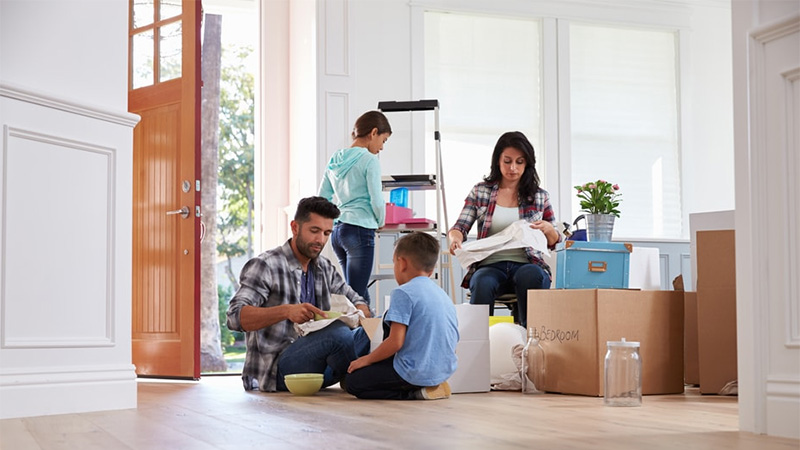How To Prepare Your Kids for the Move
While moving can be an exciting time for adults, it’s a scary feeling for kids.
The thought of leaving their friends, the life they love, and starting at a new school are all overwhelming feelings for kids of any age. Unfortunately, stress and fear can quickly and easily set in.

Before a move turns into a traumatic experience, prepare your kids as soon as possible. When you take the proper steps to prep children for a move, the process can be a breeze.
Let’s take a look at how to best prepare your kids (at all stages of life) for a move. We’ll provide the best tips for moving with infants, toddlers, young children, and teens.
Tell Them About the Move As Early as Possible
The first step to ensure your child is comfortable moving is to tell them about it as early as possible.
In order to help your children feel involved during the moving process, it’s crucial to give them a sense of control when they feel uneasy. Younger children can find out about moving closer to the moving date, while older children should know as early as possible.
According to NDMS, when a move is sprung on children they can feel like you were hiding a massive decision from them. Instead, let them know that you’re planning to move and keep them updated throughout the steps. Let them look at potential homes and give feedback when they want to. If they’re old enough, you can also let them pick out their room decor.
Let them know they’ll be able to spend plenty of time with their friends before the move and they’ll be able to keep in touch even after the move.
Moving With Infants and Toddlers
Moving with younger children is usually easier than older ones because they don’t fully understand what’s happening.
Even though they may not understand what’s going on, small children can pick up on stress and chaos — so for the sake of your kids, try to keep them out of stressful or hectic moving situations.
For toddlers and infants, transfer their beds and room items last during a move. It’s best not to change up their room decor or bedding in the new home, either. Keeping things consistent will make them feel comfortable, and the move will be less noticeable to them.
On moving day, be sure to keep their favorite blankie, toys, and comforting items with them in the car or plane.
To keep smaller children at ease during a move, have a family member or friend come over to help on the big day. They can play with your children to occupy them and keep them out of the way of movers or dangerously large boxes.
Moving Young Children
Children who are already in school between the ages of 6 and 12 won’t be as easy to move with as toddlers, but they will be easier than your average teenager.
Young children tend to find moving a mortifying experience, especially if they are moving schools and have to say goodbye to their best buddies.
Not every young child will be less-than-thrilled to move, though. If your child hasn’t made good friends around the area, they might be excited about a change.
Regardless of the circumstances, make sure you’re reassuring your child that everything will be alright. Try to get them excited about the move by telling them about opportunities to make new friends and start fresh. Again, this is a great opportunity to get them involved with the move, which will make them feel more comfortable with it.
Before moving, show your young children pictures of their new school and potential favorite places based on your child’s interests (arcades, amusement parks, skate parks, recreation centers, or malls).
If you aren’t moving far away, consider planning sleepover parties with old friends to make the transition easier. Also, make a plan for your kids to keep in touch with their friends. Set up video calls or start a pen pal system if they’re old enough to write.
Moving Teens
Not to be dramatic, but moving with a teenager can become a nightmare if you aren’t careful and strategic.
Teenagers are more likely to rebel against a move for many reasons. Older children will have relationships they have put a lot of effort into and won’t like having to start over with only a few years left of school.
Start off by letting your teen know that you understand where they are coming from. If you’ve been through the experience before as a teenager, tell them about your experience. Empathizing with them is a great way to make them feel at ease and that the moving process is doable — even exciting. Give them time to let out their feelings before trying to reason with them.
Once they’ve gotten through the initial shock of moving, try using the experience as a lesson. Tell your teenager that they’ll face big life changes, and instead of letting the changes turn their world upside down, have an optimistic outlook.
Remind your children that you are there for them and that they don’t have to go through the change alone. You are here to help them and be there for them, whatever they need.
If your teen is close to finishing high school, consider letting them stay with a friend or relative if it’s feasible and in the best interest of your child. Letting them finish school instead of starting a new one with a year or two left will make a world of difference. Of course, this is not always the case, and life happens, but it is an option for older teenagers and young adults.
After Moving With Children
Moving brings out an assortment of feelings, from stress to excitement; try to hype up the excitement part.
When moving, it’s important to make sure your child feels okay about the whole process. No matter the age, let them know about the move as soon as possible, try to get them involved with the process, give them reassurance, and make the moving process as seamless as possible for them.
After you move, try to establish a routine as early as possible with your kids. Plan many family activities for bonding to show them they are not alone in the process.
Remember to stay positive, and you’ll pull off a successful move with your children!



